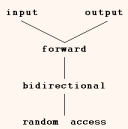| ←Previous Entry | Next Entry→ | |||||||||||||||||||||||||||||||||||||||||||||||||||||||||||||||
|
September I could do graphics, random partitions or investigate vectors....hmmm. How about vectors? Or do I need lists? Let's see... Alexander Stepanov and Meng Lee at HP are credited with developing the Standard Template Library (STL) which is a proof of concept for generic programming with templates. The three essential components of the STL are containers (popular templatized data structures), iterators and algorithms. A container is a data structure capable of storing any kind of object and there are three types of these: first-class containers, adapters and near containers. There are member functions associated with each STL container and some member functions which are common to all. A vector is a dynamically resizable array--and these are what I'm interested in using to improve the partition code from yesterday. Later we can find opportunities for using other containers such as the list and the deque (double-ended queue.) STL iterators are similar to pointers and are used to manipulate container elements, or even simple arrays. Algortihms are functions that do standard data processing such as sorting and comparing. Each first-class container’s supported iterator type determines whether the container admits a particular algorithm. Iterators give access to container elements and enable many of the STL algorithms to be applied to several containers independent of the container implementation. As long as a container’s iterators support the minimum requirements of the algorithm, the algorithm can process that container’s elements. This means you can create new algorithms to handle the elements of different container types. Here's a table of container types from chapter 21 of Deitel.
You can find this and other good info at http://ptgtraining.com/CyberClassroom/0025o8/ch21/21_01/content.htm About Iterators Iterators keep track of the state of particular containers on which they operate, and so need to be implemented in ways specific to the type of container, though some iterator operations are the same for all containers. The dereferencing operator (*), for example, will always dereference an iterator so that you can use the element to which it points. Likewise, the ++ operator will move the iterator to the next element. STL first-class containers provide member functions begin() and end(), very much reminiscent of the OpenGL functions, no? Function begin() returns an iterator pointing to the first element of the container. Function end() returns an iterator pointing to the first element past the end of the container (an element that doesn’t exist). If iterator i points to a particular element, then ++i points to the “next” element and *i refers to the element pointed to by i. The iterator resulting from end() can be used only in an equality or inequality comparison to determine whether the “moving iterator” (i in this case) has reached the end of the container. An object of type iterator refers to a container element that can be modified. A const_iterator refers to a container element that cannot be modified. Iterators with sequences (also called ranges) can be input sequences or output sequences or in containers. The program of below (from Deitel) demonstrates input from the standard input (a sequence of data for input into a program), using an istream_iterator, and output to the standard output (a sequence of data for output from a program), using an ostream_iterator. The program inputs two integers from the user at the keyboard and displays the sum of the integers.
If you're like me, you might be thinking, "Whoa, that's a lot of work to do something that could more easily have been done without iterators!" And you'd be...right? The point being that this new power will allow us to do new better things...I hope. Here's the unsurprising output:
The istream_iterator extracts int values in a type-safe manner from the standard input object cin and iterator inputInt is dereferenced to read the first integer from cin and assigns that integer to number1. Similarly, the ostream_iterator inserts int values in the standard output object cout and then an integer is output to cout by assigning to *outputInt the sum of number1 and number2. Notice the use of the dereferencing operator * to use *outputInt as an lvalue in the assignment statement. The iterator must be incremented with ++ (both preincrement and postincrement can be used) to output another value.
A Now a Word About Algorithms
|
||||||||||||||||||||||||||||||||||||||||||||||||||||||||||||||||
